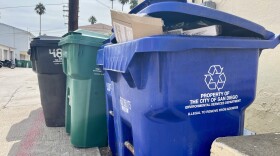New York City awakened Tuesday to a flooded subway system, shuttered financial markets and hundreds of thousands of people without power a day after a wall of seawater and high winds slammed into the city, destroying buildings and flooding tunnels.
Scenes of the damage were everywhere. At least 50 flooded homes in Queens caught fire and were destroyed. A hospital removed patients on stretchers and 20 babies from neonatal intensive care, some on respirators operating on battery power.
Where usually bustling crowds and traffic jams streamed through sidewalks, streets and subways, they were largely empty. And high above midtown, the broken boom of a crane continued to dangle precariously over a neighborhood.
"Oh, Jesus. Oh, no," said Faye Schwartz, 65, Tuesday morning as she surveyed the damage in her Brooklyn neighborhood, where cars were strewn like leaves, planters deposited in intersections and green metal Dumpsters tossed on their sides.
The storm was once Hurricane Sandy but combined with two wintry systems to become a huge hybrid storm whose center smashed ashore late Monday in New Jersey. New York City was perfectly positioned to absorb the worst of its storm surge — a record 13 feet.
Water lapped over the seawall in Battery Park City, flooding rail yards, subway tracks, tunnels and roads. Rescue workers floated bright orange rafts down flooded downtown streets, while police officers rolled slowly down the street with loudspeakers telling people to go home.
"We knew that this was going to be a very dangerous storm, and the storm has met our expectations," Mayor Michael Bloomberg said. "This is a once-in-a-long-time storm."
In Queens, nearly 200 firefighters tried to contain an enormous blaze that consumed 50 homes in the Breezy Point neighborhood. They had to use a boat to make rescues, firefighters told WABC-TV. They climbed an awning to reach about 25 trapped people and take them down to a boat.
Officials weren't immediately able to pin down the cause of the blaze.
Water surged into two major commuter tunnels — the Brooklyn Battery and the Queens Midtown — along with seven subway tunnels under the East River. The agency is assessing damage and will restore the system as quickly as it can, MTA Chairman Joseph Lhota said.
The rains and howling winds left a crane hanging off a luxury high-rise in midtown Manhattan, causing the evacuation of hundreds from a posh hotel and other buildings. Inspectors were climbing 74 flights of stairs to examine the crane hanging from the $1.5 billion building.
After a backup generator failed, New York University's Tisch Hospital began evacuating more than 200 patients to other facilities, including 20 babies from neonatal intensive care, some of them on respirators operating on battery power.
Without power, the hospital had no elevator service, meaning patients had to be carefully carried down staircases and outside into the weather. Gusts of wind blew their blankets as nurses held IVs and other equipment.
About 670,000 homes and businesses were without power late Monday in the city and suburban Westchester County.
In Schwartz's Brooklyn neighborhood of Red Hook, residents who ignored a mandatory evacuation order awoke to debris-strewn streets and a continued blackout. About 2 inches of mucky dirt and leaves covered streets crisscrossed by downed power lines after water sloshed 12 blocks inland.
The doors of the Fairway grocery store were blown out. Several cars left in the parking lot were shifted by flood waters overnight and were left crammed door to door.
Schwartz and her husband rode out the storm on the third floor of the residences above the Fairway and said white-capped flood waters reached at least 3 feet around the building.
"It was scary how fast the water came up," she said.
The facade of a four-story Manhattan building in the Chelsea neighborhood crumbled and collapsed suddenly, leaving the lights, couches, cabinets and desks inside visible from the street. No one was hurt, although some of the falling debris hit a car.
The city shut all three of its airports, its subways, schools, stock exchanges, Broadway theaters and closed several bridges and tunnels Monday as the weather worsened. By evening, a record 13-foot storm surge was threatening Manhattan's southern tip and utilities deliberately darkened part of the borough to avoid storm damage.
It could be several days to a week before all residents who lost power during the storm get their lights back, Miksad said.
On Tuesday, the New York Stock Exchange was to be closed again — the first time it's been closed for two consecutive days due to weather since 1888, when a blizzard struck the city.
At 4 a.m., few people were out on the streets. Times Square was lit but empty of people. Round-the-clock restaurants and bars that would have been wrapping up after last call were closed. Only a handful of taxis plied the streets — but there was an abundance of emergency and police vehicles.
Uptown, windows of apartments and businesses glowed. But to cross through midtown was to be swallowed by darkness. Only a few emergency or backup lights appeared in buildings.
Late Monday, an explosion at a substation at 14th Street and FDR Drive contributed to the power outages. No one was injured, and ConEd did not know whether the explosion was caused by flooding or by flying debris.
Earlier in the day, another 1 million customers lost power in New York City, the northern suburbs and coastal Long Island, where floodwaters swamped cars, downed trees and put neighborhoods under water.
At least six people were killed in the New York City area, most by falling trees. The dead included two boys, ages 11 and 13, who were killed when a tree fell on a home in suburban Westchester County.
On coastal Long Island, floodwaters swamped cars, downed trees and put neighborhoods under water as beachfronts and fishing villages bore the brunt of the storm. A police car was lost rescuing 14 people from the popular resort Fire Island.






